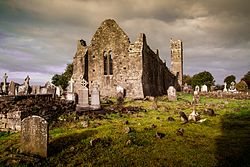
Galbally is a village in southeast County Limerick, Ireland, on the border with County Tipperary. It is located at the foot of the Galtee Mountains and at the western approach to the Glen of Aherlow. The Aherlow River, flowing down from the Galtee mountains, runs by the village, to meet the Suir at Kilmoyler a short distance north of Cahir. Galbally is in a valley overlooked by the Galtee Mountains.

Inis Cathaigh or Scattery Island is an island in the Shannon Estuary, Ireland, off the coast of Kilrush, County Clare. The island is home to a lighthouse, a ruined monastery associated with Saints Senan and Canir, an Irish round tower and the remains of an artillery battery. The last residents left in 1969. Most of the island is now owned by the Office of Public Works, who run a small visitor centre and carry out repairs and maintenance on the island; it was bought by Dúchas in 1991.The Irish name Inis Cathaigh was formerly anglicised Iniscathy, which later became Iniscattery and finally Scattery.

Clonfert Cathedral is a cathedral of the Church of Ireland in Clonfert, County Galway in Ireland. It is in the ecclesiastical province of Dublin. Previously the cathedral of the Diocese of Clonfert and then one of three cathedrals in the United Dioceses of Limerick and Killaloe, it is now one of five cathedrals in the Diocese of Tuam, Limerick and Killaloe.
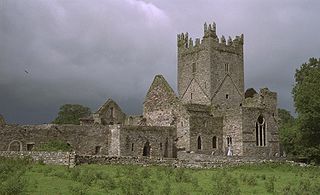
Jerpoint Abbey is a ruined Cistercian abbey, founded in the second half of the 12th century in County Kilkenny, Ireland. It is located 2.5 km south west of Thomastown on the R448 regional road. There is a visitor centre with an exhibition. It has been declared a national monument and has been in the care of the Office of Public Works since 1880.
Dooradoyle is a large suburb of Limerick, Ireland. It is one of Limerick's newer suburbs, and is home to the campus of University Hospital Limerick and the Crescent Shopping Centre.
Domnall Mór Ua Briain, or Domnall Mór mac Toirrdelbaig Uí Briain, was King of Thomond in Ireland from 1168 to 1194 and a claimant to the title King of Munster. He was also styled King of Limerick, a title belonging to the O'Brien dynasty since Brian Boru's sacking of the Hiberno-Norse city state after the Battle of Sulcoit in the 10th century.
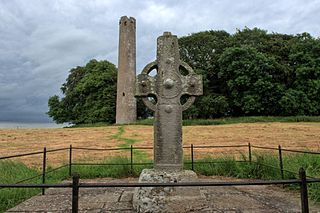
Kilree is a former Christian monastery and National Monument located in County Kilkenny, Ireland.

Dromiskin Monastery is a medieval monastery and National Monument located in Dromiskin, County Louth in Ireland.
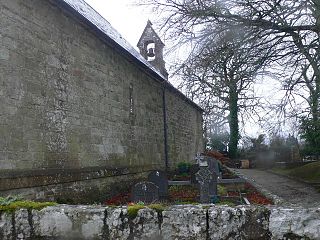
St. Cronan's Church is a 10th-century Church of Ireland church in Tuamgraney, County Clare, Ireland. It is the oldest church in continuous use in Ireland. The Tuamgraney parish operates as a unit with the Mountshannon parish in the Killaloe Union of parishes in the Diocese of Tuam, Limerick and Killaloe.

Inishmaine Abbey is a former Augustinian monastery and National Monument located in County Mayo, Ireland.

Castlelyons Friary is a former Carmelite Priory and National Monument located in County Cork, Ireland.

Killeen Cowpark is a medieval church and a National Monument in County Limerick, Ireland.

Kilrush Church, also called St. Munchin's Church, is a medieval church and a National Monument in Limerick City, Ireland.
Clonkeen Church is a medieval church and a National Monument in County Limerick, Ireland.

Monasteranenagh Abbey is a medieval friary and National Monument located in County Limerick, Ireland.
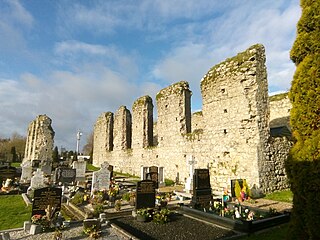
Clane Friary, also called Clane Abbey, is a former friary of the Order of Friars Minor Conventual located in Clane, Ireland.

Dísert Óengusa is a medieval hermitage and National Monument located in County Limerick, Ireland.
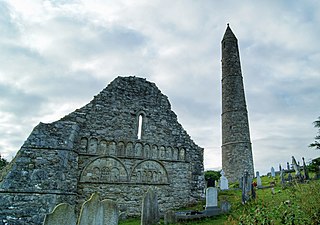
St. Declan's Monastery, containing the remains of Ardmore Cathedral, is a former monastery and National Monument located in County Waterford, Ireland.

Saul Monastery is a former Christian monastery located in County Down, Northern Ireland. It is traditionally associated with the 5th-century Saint Patrick, who is said to have founded it shortly after arriving in Ireland, and having died there at the end of his missionary work.
